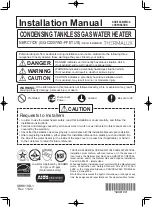
Innovation Water Heaters
– Edge [i] Controller
Venting and Combustion Air Design Guide
TAG-0090_A
•
GF-5056
•
2/20/2020
Technical Support
•
(800) 526-0288
•
Mon-Fri, 8 am - 5 pm EST Page 18 of 39
3.
VENT SYSTEM
The heater vent is fundamental for correct operation. Being a condensing heater, combustion
gases are discharged at a very low temperature. It is therefore necessary for the venting system
to be perfectly impermeable to combustion products condensate and to be made of corrosion
resistant materials. Typical Category IV venting and ducted combustion air illustrations are shown
in Figures 3 through 7. The various funnel joints shall be well sealed and/or equipped with suitable
gaskets, in order to avoid any condensate drain and/or air intake. Ensure that the heater
’s vent
section and height conform to national and local regulations (see Section 1.2 APPLICABLE
FEDERAL CODES of this guide).
The exhaust vent system must be pitched back toward the water heater unit by a minimum of 1/4
inch per foot (21 mm/m) of duct length to enable condensate to drain back to the unit for disposal.
Low spots in the vent must be avoided to prevent the condensate from collecting.
The condensate trap assembly is located directly below the exhaust manifold. Plastic hose should
be connected to the trap assembly and run to drain. Care should be taken to avoid hose kinks
and to avoid raising the hose above the trap assembly. Condensate should flow freely to drain.
The condensate-to-drain run must not be hard-piped so the trap can be removed periodically for
maintenance purposes.
If the condensate must be lifted above the trap assembly to a drain, it should be drained into a
sump. From there, a pump can lift the condensate away.
Innovation-Edge units will produce the following maximum condensate quantities in the full
condensing mode:
INNOVATION-EDGE
INN 600N
4.5 gallons per hour
0.28 L/min
INN 800N
6 gallons per hour
0.38 L/min
INN 1060N
8 gallons per hour
0.50 L/min
INN 1350N
11 gallons per hour
0.69 L/min
Condensate drain systems must be sized for full condensing mode.
In multiple water heater applications, it is common to manifold these drains together in a plastic
pipe manifold to a floor drain. Condensate manifolds must be large enough to handle the
anticipated flow and must be properly secured and protected. Manifolds are generally located
behind the units so that short runs of plastic tubing into the manifold can be used for the
condensate drain. A base drain must be installed at the bottom of vertical common flue piping.
The pH level of the condensate produced by AERCO water heaters ranges between 3.0 and 3.2.
The installation should be designed in accordance with local codes that specify acceptable pH
limits. If required, any type of commercially available neutralizer may be used. For water heaters
designed for connection to gas vents or chimneys, vent installations shall be in accordance with
Part 7, Venting of Equipment, of the National Fuel Gas Code, ANSI Z223.1, or Section 7,
Venting Systems and Air Supply for Appliances, of the CAN/CSA B149, Installation Codes, or
applicable provisions of the local building codes.
















































